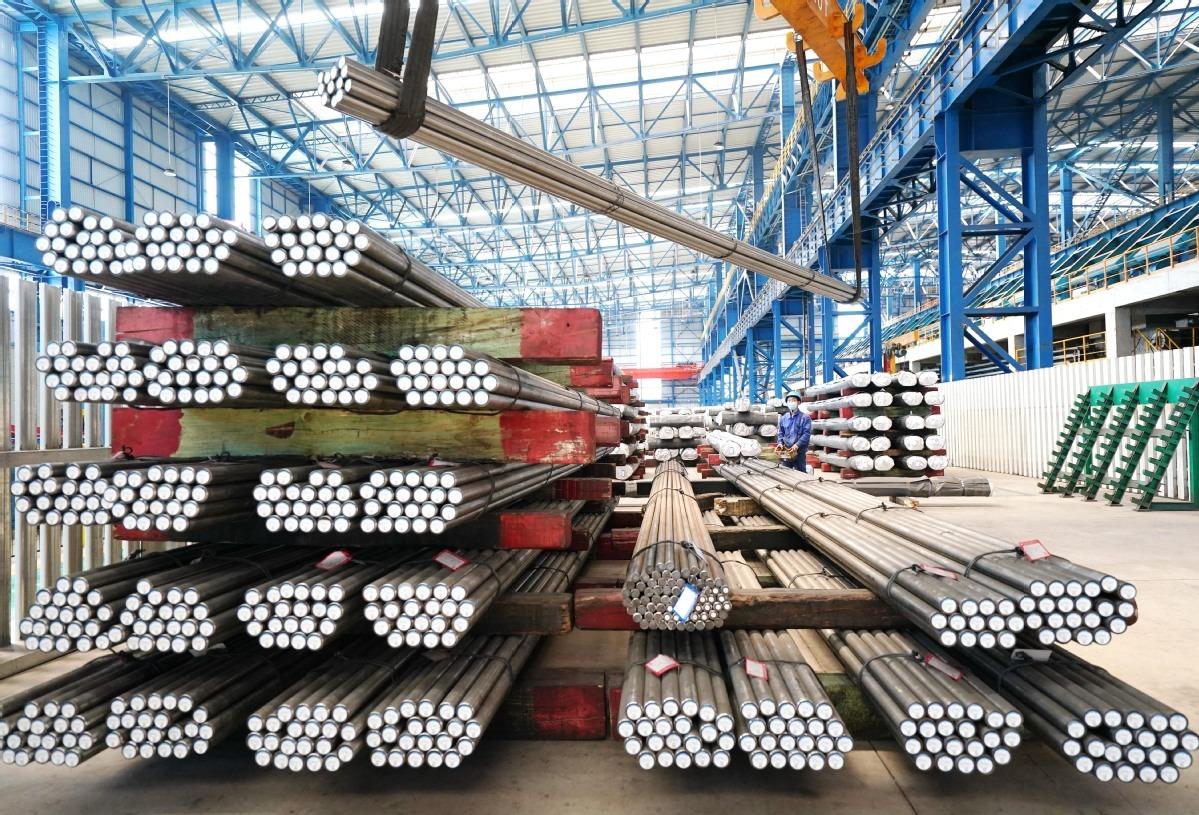Low-carbon transformation seen as holding key to industry's future growth
 A worker arranges steel bars at a production facility in Shijiazhuang, Hebei province, in May. (PHOTO / XINHUA)
A worker arranges steel bars at a production facility in Shijiazhuang, Hebei province, in May. (PHOTO / XINHUA)
Further efforts are expected to actively upgrade technologies in steel smelting, optimizing production processes and promoting recycling for the low-carbon transformation of the energy-intensive steel industry to foster high-quality development, experts said.
Such moves will address challenges posed by the European Union's Carbon Border Adjustment Mechanism and pressure from downstream industries like automobiles that are urgently demanding eco-friendly steel materials, they said.
"Additionally, efforts should be made to promote product and equipment iteration and upgrading, enhance the energy efficiency of steel production processes, and develop carbon capture, utilization and storage technologies to support carbon neutrality in the steel industry," said Mao Xinping, an academician at the Chinese Academy of Engineering and a professor at the University of Science and Technology Beijing.
The CBAM puts a price on the carbon emitted during the production of carbon intensive goods entering the EU. It started trial operation in October last year, and will be implemented from 2026 onward.
The China Iron and Steel Association has estimated that implementation of the CBAM would increase the export cost of steel products by 4-6 percent. Including certificate fees, this will result in an additional expenditure of $200-$400 million for steel enterprises annually.
Lu Shize, an official of the Ministry of Ecology and Environment, said that taking economic measures to reduce emissions has become a global consensus, with carbon pricing mechanisms as an important emission reduction measure
"In the context of global carbon reduction, China's steel industry faces enormous challenges and important opportunities. Achieving carbon neutrality in China's steel industry requires systematic basic theories, a series of major technological innovations, and massive scientific and technological resources and financial investment," Mao said at a recent forum held by the China Metallurgical Industry Planning and Research Institute.
According to the World Steel Association, China, which is the world's largest steel producer, currently accounts for over half of global steel production.
CISA data showed that in 2023, China's crude steel production exceeded 1 billion metric tons, flat compared to the previous year. Steel production was 1.36 billion tons, a year-on-year increase of 5.2 percent.
Lu Shize, deputy director of the department of climate change of the Ministry of Ecology and Environment, said that taking economic measures to reduce emissions has become a global consensus, with carbon pricing mechanisms as an important emission reduction measure.
Lu said that China has implemented a carbon pricing mechanism with carbon emission rights trading as a core element, actively constructing a national unified carbon market that is compatible with international standards.
"In the future, we will steadily expand the coverage of the carbon market to include more industries. For the steel industry, being included in the national carbon market faces a series of challenges such as large carbon emissions and weak data foundations," Lu said.
 This aerial photo taken on July 22, 2023 shows a warehouse of Shougang Jingtang United Iron & Steel Co Ltd in Tangshan, north China's Hebei province. (PHOTO / XINHUA)
This aerial photo taken on July 22, 2023 shows a warehouse of Shougang Jingtang United Iron & Steel Co Ltd in Tangshan, north China's Hebei province. (PHOTO / XINHUA)
"Steel enterprises should focus on four key areas to tackle such challenges: familiarity with the rules of the carbon market; reducing carbon emissions through a series of measures; strengthening the management of carbon emission data; and actively participating in trading and fulfilling their obligations," he added.
Song Xiangdang, deputy head of the Hebei provincial bureau of industry and information technology, said that the province has reduced excess capacity, continuously optimized its industrial layout, and made significant progress in energy conservation and emission reduction
Wen Gang, director of iron and steel at the raw material and industry department of the Ministry of Industry and Information Technology, emphasized four key areas for the solid promotion of an upgrade and green transition of China's steel industry — focusing on promoting stable growth, accelerating equipment updates and technological upgrades, advancing digital transformation, and promoting green and low-carbon development.
Hebei province in northern China is one of the country's steel producing hubs. In recent years, the province's steel industry has continuously strengthened its industrial transformation and continuously explored new paths toward green, digital and high-quality development.
Song Xiangdang, deputy head of the Hebei provincial bureau of industry and information technology, said that the province has reduced excess capacity, continuously optimized its industrial layout, and made significant progress in energy conservation and emission reduction.
Song said that Hebei's steel industry has the largest number of Grade A environmental performance enterprises — a rating system of the Ministry of Ecology and Environment — and national-level green factories. The province has also enhanced technological innovation, and strengthened digital transformation, Song added.


